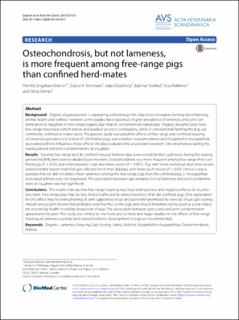Osteochondrosis, but not lameness, is more frequent among free-range pigs than confined herd-mates
Etterlin, Pernille Engelsen; Morrison, David A.; Österberg, Julia; Ytrehus, Bjørnar; Heldmer, Eva; Ekman, Stina
Peer reviewed, Journal article
Published version

Åpne
Permanent lenke
https://hdl.handle.net/11250/3058178Utgivelsesdato
2015Metadata
Vis full innførselSamlinger
- Publikasjoner fra CRIStin - NINA [2364]
- Scientific publications [1392]
Sammendrag
Organic pig production is expanding and amongst the objectives of organic farming are enhancing
animal health and welfare. However, some studies have reported a higher prevalence of lameness and joint condemnation
at slaughter in free-range/organic pigs than in conventionally raised pigs. Organic slaughter pigs have
free-range housing in which indoor and outdoor access is compulsory, while in conventional farming the pigs are
commonly confined to indoor pens. The present study evaluated the effects of free-range and confined housing
on lameness prevalence in a herd of 106 finisher pigs, and whether osteochondrosis and Erysipelothrix rhusiopathiae
associated arthritis influences these effects. We also evaluated the association between clinical lameness during the
rearing period and joint condemnations at slaughter.
Results: Seventy free-range and 36 confined housed fattener pigs were scored for their gait twice during the rearing
period and 848 joints were evaluated post mortem. Osteochondrosis was more frequent among free-range than confined
pigs (P < 0.05), and when present it was also more severe (P < 0.001). Pigs with more numerous and more severe
osteochondral lesions had their gait affected more than did pigs with fewer such lesions (P < 0.05). Hence it was a
paradox that we did not detect more lameness among the free-range pigs than the confined pigs. E. rhusiopathiae
associated arthritis was not diagnosed. The association between gait remarks/clinical lameness and joint condemnations
at slaughter was not significant.
Conclusions: The results indicate that free-range housing may have both positive and negative effects on locomotory
traits. Free-range pigs may be less clinically affected by osteochondrosis than are confined pigs. One explanation
for this effect may be strengthening of joint supportive tissue and pain relief promoted by exercise. Visual gait scoring
missed serious joint lesions that probably were harmful to the pigs, and should therefore not be used as a sole indicator
of joint/leg health in welfare inspection of pigs. The association between gait scores and joint condemnation
appeared to be poor. This study was limited to one herd, and so more and larger studies on the effects of free-range
housing on lameness severity and osteochondrosis development in pigs are recommended.
Keywords: Organic, Lameness, Housing, Gait scoring, Joints, Arthritis, Erysipelothrix rhusiopathiae, Osteochondrosis,
Welfare
